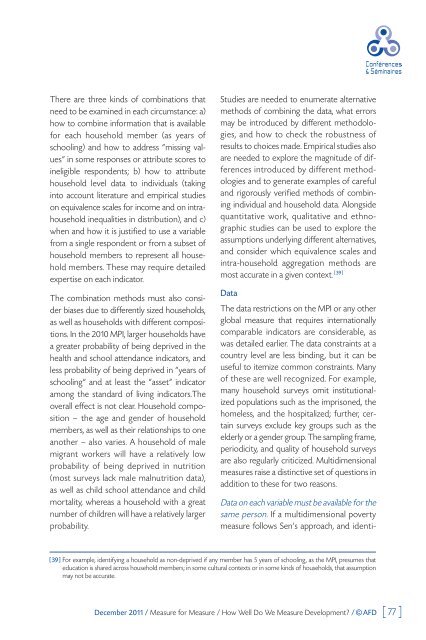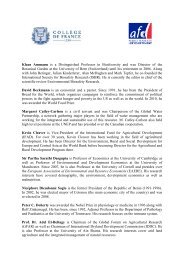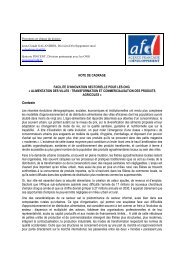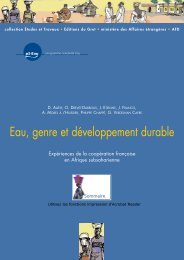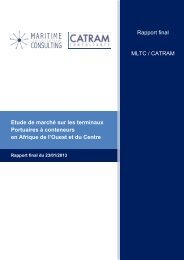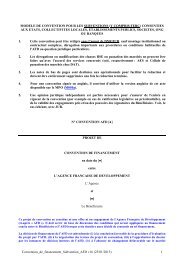Paris School of Economics - L'Agence Française de Développement
Paris School of Economics - L'Agence Française de Développement
Paris School of Economics - L'Agence Française de Développement
You also want an ePaper? Increase the reach of your titles
YUMPU automatically turns print PDFs into web optimized ePapers that Google loves.
There are three kinds <strong>of</strong> combinations that<br />
need to be examined in each circumstance: a)<br />
how to combine information that is available<br />
for each household member (as years <strong>of</strong><br />
schooling) and how to address “missing values”<br />
in some responses or attribute scores to<br />
ineligible respon<strong>de</strong>nts; b) how to attribute<br />
household level data to individuals (taking<br />
into account literature and empirical studies<br />
on equivalence scales for income and on intrahousehold<br />
inequalities in distribution), and c)<br />
when and how it is justified to use a variable<br />
from a single respon<strong>de</strong>nt or from a subset <strong>of</strong><br />
household members to represent all household<br />
members. These may require <strong>de</strong>tailed<br />
expertise on each indicator.<br />
The combination methods must also consi<strong>de</strong>r<br />
biases due to differently sized households,<br />
as well as households with different compositions.<br />
In the 2010 MPI, larger households have<br />
a greater probability <strong>of</strong> being <strong>de</strong>prived in the<br />
health and school attendance indicators, and<br />
less probability <strong>of</strong> being <strong>de</strong>prived in “years <strong>of</strong><br />
schooling” and at least the “asset” indicator<br />
among the standard <strong>of</strong> living indicators.The<br />
overall effect is not clear. Household composition<br />
— the age and gen<strong>de</strong>r <strong>of</strong> household<br />
members, as well as their relationships to one<br />
another — also varies. A household <strong>of</strong> male<br />
migrant workers will have a relatively low<br />
probability <strong>of</strong> being <strong>de</strong>prived in nutrition<br />
(most surveys lack male malnutrition data),<br />
as well as child school attendance and child<br />
mortality, whereas a household with a great<br />
number <strong>of</strong> children will have a relatively larger<br />
probability.<br />
Studies are nee<strong>de</strong>d to enumerate alternative<br />
methods <strong>of</strong> combining the data, what errors<br />
may be introduced by different methodologies,<br />
and how to check the robustness <strong>of</strong><br />
results to choices ma<strong>de</strong>. Empirical studies also<br />
are nee<strong>de</strong>d to explore the magnitu<strong>de</strong> <strong>of</strong> differences<br />
introduced by different methodologies<br />
and to generate examples <strong>of</strong> careful<br />
and rigorously verified methods <strong>of</strong> combining<br />
individual and household data. Alongsi<strong>de</strong><br />
quantitative work, qualitative and ethnographic<br />
studies can be used to explore the<br />
assumptions un<strong>de</strong>rlying different alternatives,<br />
and consi<strong>de</strong>r which equivalence scales and<br />
intra-household aggregation methods are<br />
most accurate in a given context. [39]<br />
Data<br />
The data restrictions on the MPI or any other<br />
global measure that requires internationally<br />
comparable indicators are consi<strong>de</strong>rable, as<br />
was <strong>de</strong>tailed earlier. The data constraints at a<br />
country level are less binding, but it can be<br />
useful to itemize common constraints. Many<br />
<strong>of</strong> these are well recognized. For example,<br />
many household surveys omit institutionalized<br />
populations such as the imprisoned, the<br />
homeless, and the hospitalized; further, certain<br />
surveys exclu<strong>de</strong> key groups such as the<br />
el<strong>de</strong>rly or a gen<strong>de</strong>r group. The sampling frame,<br />
periodicity, and quality <strong>of</strong> household surveys<br />
are also regularly criticized. Multidimensional<br />
measures raise a distinctive set <strong>of</strong> questions in<br />
addition to these for two reasons.<br />
Data on each variable must be available for the<br />
same person. If a multidimensional poverty<br />
measure follows Sen’s approach, and i<strong>de</strong>nti-<br />
[39] For example, i<strong>de</strong>ntifying a household as non-<strong>de</strong>prived if any member has 5 years <strong>of</strong> schooling, as the MPI, presumes that<br />
education is shared across household members; in some cultural contexts or in some kinds <strong>of</strong> households, that assumption<br />
may not be accurate.<br />
December 2011 / Measure for Measure / How Well Do We Measure Development? / © AFD [ 77 ]


